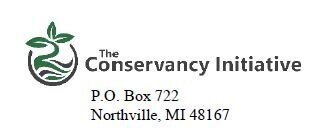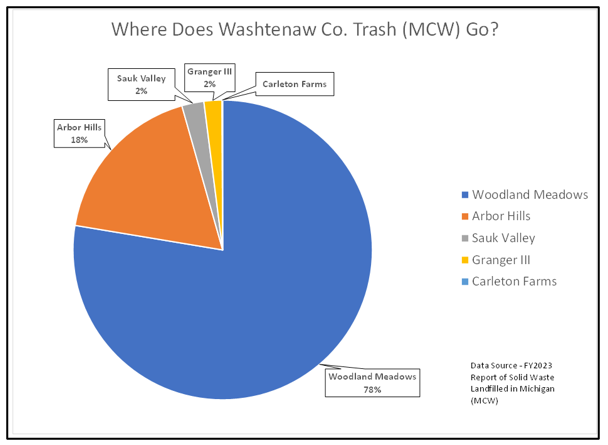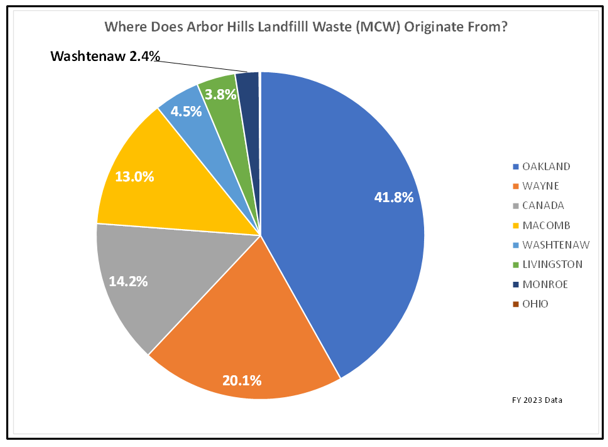The Arbor Hills Landfill should reach its capacity within six years or less. The landfill owner, Green for Life (GFL), is expected to request additional capacity later this year. An expansion to the property directly north of the current landfill, north of Six Mile Road, is possible. To prepare for the upcoming landfill debate. The Conservancy Initiative thoroughly analyzed the FY 2023 Annual Report on Solid Waste Landfilled in Michigan, extracting data that may interest our readers.
Imported Wastes
Michigan has an abundance of landfills, and its tipping fees (fees or taxes imposed by the state) are significantly lower than those in neighboring states. The lower fees create an incentive for imported waste from Canada and neighboring states to enter Michigan. Approximately 15% (by weight) of the total waste entering Michigan landfills in 2023 FY originated in Canada; another 5% originated in other states.
At the Arbor Hills landfill, 14% of the Municipal and Commercial Waste (MCW) and 7% of the total waste[1] during FY 2023 originated in Canada. This is a significant reduction from FY 2022 when 25% of the MCW originated in Canada. Decreasing or eliminating waste from Canada could extend the landfill’s expected life by 1 – 2 years.
The Michigan State legislature is considering increasing Michigan’s tipping fees to a level comparable to our neighboring states. The increased tipping fees will discourage imported waste and encourage recycling activities. The Conservancy Initiative strongly supports the increased tipping fees.
Expected Landfill Life or Remaining Capacity
Landfill Capacity or the expected landfill life is conservatively estimated by dividing the permitted capacity remaining by the capacity used during the most recent fiscal year. The total landfill capacity in Michigan has an estimated life of 26 years, while the Arbor Hills Landfill has an estimated life of approximately six years.
Does Washtenaw County Need Additional Landfill Capacity?
Michigan’s Solid Waste Regulations were updated in 2023 to decrease landfill dependence by increasing the recycling rate. A goal of increasing recycling from 19% to 30% by 2025 and 45% by 2030 has been set. The updated regulations and increased tipping fees will create recycling incentives and increase our landfills' life expectancy.
Each Michigan County will be forming a Materials Management Planning committee this year. The committees will be tasked with developing Material Management Plans (MMP) to ensure assets and plans are in place to recycle or dispose of waste materials generated over the next ten years. Each county does not need to have its own landfill; an agreement with recycling and disposal facilities outside the county will satisfy future planning requirements.
The Arbor Hills Landfill is the only Municipal Solid Waste Landfill (Type II) in Washtenaw County, and it has a very limited life (approximately six years). Washtenaw County will be accessing the need for a new landfill or increased capacity at Arbor Hills during the preparation of their MMP.
Where is Washtenaw County’s waste sent for disposal?
Approximately 80% of the trash (MCW) generated within Washtenaw County is disposed of at Wayne County landfills (Woodland Meadow and Sauk Valley). The shutdown of Arbor Hills should have little impact on Municipal and Commercial waste collection in Washtenaw County.
Table 4 - Where does Washtenaw County Trash Go Today?
Who is benefitting from the Arbor Hills landfill?
Only 2.4% of the Municipal and Commercial Waste (MCW) entering the Arbor Hills Landfill originated in Washtenaw County. Oakland County, Wayne County, and Canada account for over 75% of the trash (MCW) entering the Arbor Hills Landfill. Michigan's most progressive, environmentally friendly county serves as a landfill for Canada and counties other than Washtenaw.
Table 5 - Who Sends Trash to Arbor Hills?
The Conservancy Initiative does not support an expansion of Arbor Hills or a new landfill North of Six Mile Road. If you agree, please contact all your elected officials to make sure they understand. SPEAK UP!
Find your State Representative <Click Here>
Find your State Senator <Click Here>
[1] Total Waste included Municipal and Commercial Waste, Industrial Waste (IW), Construction and Demolition (CD), Alternative Daily Cover (ADC), and Other Waste. MCW is the largest waste stream for Type II landfills.






